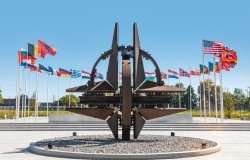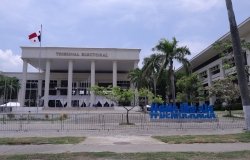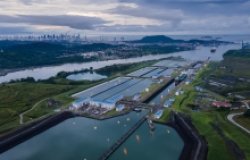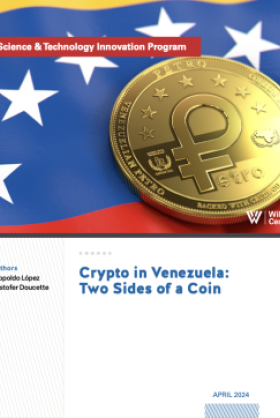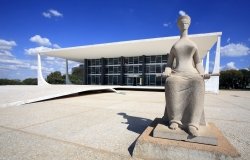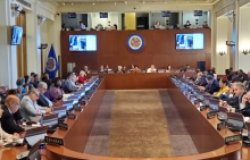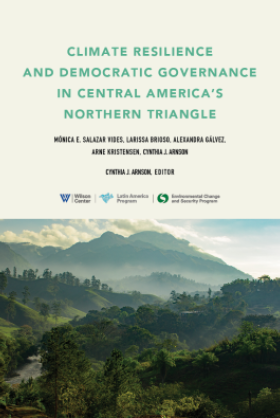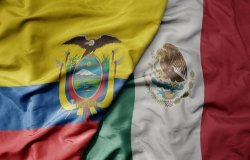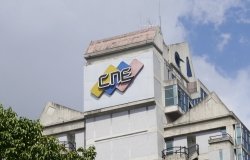Kennan Cable No.20: Understanding Russian Priorities in Latin America
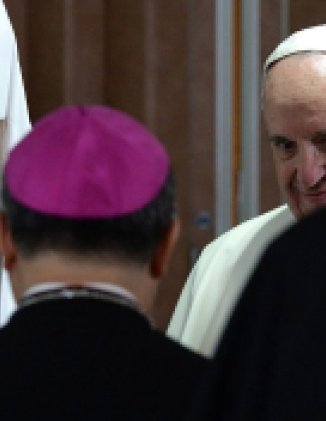

On 13 February 2016, the front pages of major Russian and Latin American newspapers looked almost identical: they all published a photograph of Pope Francis and Russian Patriarch Kirill during their meeting in Havana, Cuba—the first ever encounter of the heads of the Roman Catholic and the Russian Orthodox Churches. The choice of venue was no accident: Russia views Latin America as a convenient environment for Moscow to address a number of items on its domestic and foreign policy agendas. In particular, the historic encounter and its setting provided a perfect picture on Russian television: It showcased Russia’s success in restoring its global influence and, at the same time, the futility of efforts to isolate it on international arena. For President Vladimir Putin, this image alone easily outweighed the arguments of those at home who might criticize the rapprochement with Rome as a dangerous concession to the Vatican.[i]
But meeting the Pope was only the beginning of Kirill´s extended trip to the Americas to see regional leaders he already knew. A visit to Patriarch Kirill is one of the “musts” on the itinerary of almost all Latin American leaders when they travel to Moscow. Visiting leaders recognize the important symbolic role the Orthodox Church plays in constructing and strengthening the new Russian identity. Here the interests of the Russian state and the Church coincide, and this explains in part the increased influence of the Russian Orthodox Church in Latin America.
This time for Russia, it is not about backing a few regional communist leaders or movements, as was the case in the Soviet era. Now Russia promotes, in conjunction with the Orthodox Church, its strong support for “universal traditional values” on a global scale, a message that resonates well in many conservative sectors of Latin American societies. From this perspective, the meeting in Havana served as yet more evidence that Russia is returning to the region with an agenda that is not limited to sporadic arms sales and contacts with anti-American governments. Today, Russia seeks to establish a longer-term, multifaceted presence in the Western Hemisphere.
The Return of the Russians
During the Cold War, the Cuban Revolution allowed Moscow to establish its first true base in the Western Hemisphere. For many years, Havana was a major recipient of Soviet direct aid. The USSR supported other leftist regimes in the region throughout the Cold War. However, by the end of the 1980s, with the decline of Soviet economic power, Moscow’s efforts and influence in Latin America dropped sharply, allowing experts to conclude that the “Russians aren’t coming.” [ii]
The newly independent Russian state inherited a legacy of relationships with Latin America from the Soviet Union that were previously based on shared ideology. Russia soon found that restoring those links to their Soviet heyday would require patronage support that Kremlin could no longer afford and no longer wished to provide. Thus, for the most of the 1990s, Russia was largely absent from Latin America. Considering Russia’s economic problems and its initial desire to cooperate with Western powers, the Boris Yeltsin government did not prioritize this distant region.
That began to change in the late 1990s, with increased visits of Russian government officials, including then-Minister for Foreign Affairs Yevgeny Primakov, to several Latin American countries. Russia wanted to forge new friendships, and rekindle old ones—especially with those political figures who had troubled relations with the United States, like Colombia’s President Ernesto Samper. Russia was among only a handful of countries that openly supported Samper, despite accusations that he received campaign funds from a drug cartel. Bogota returned the favor by purchasing Russian military helicopters instead of equipment made in the United States under a prior deal already approved by Congress.
In addition to Russia’s diplomatic outreach in the late 1990s, many Russian companies, primarily from the energy sector and military-industrial complex, rushed to Latin America seeking new markets and opportunities. Russian trade with the region did increase, especially with Argentina, Brazil, and Mexico. Nevertheless, the level of trade never came close to Russian trade with its major partners in Europe and Asia.[iii] Moreover, Russian companies that hoped to make deals in Latin America, especially in manufacturing, often lacked the required expertise and proved unable to compete with other players. As a result, many Russian companies soon left the region.[iv]
Why Russia Matters to Latin America
The relatively recent major improvement in Russia-Latin America relations followed Latin America’s political left turn in the 2000s.[v] However, contrary to the Soviet period, it was not a common ideological orientation that brought Russia closer to Lula’s Brazil, Kirchner’s Argentina and the countries of the Bolivarian Alliance for the Peoples of Our America (ALBA). The reengagement took place because it promised tangible mutual political and some economic benefits for both Russia and its Latin American partners.
Like Russia, Brazil values its membership in the BRICS (Brazil, Russia, India, China, South Africa) consortium as a symbol of recognition as a global player. In the case of Argentina, Russia provided political support at a key moment during internal and external difficulties experienced by the country. Relations between Russia and the key ALBA countries (Venezuela, Cuba, and Nicaragua) benefited from the absence of mutually uncomfortable political questions: The Latin American side knew that Russia would never ask questions about human rights violations in Cuba, persecution of the opposition in Venezuela, or the abuse of power in Nicaragua. At the same time, Russia knew that neither Caracas, Havana, nor Managua would ever question the way politics are conducted in Russia.
Since the latter 2000s, the Kremlin’s growing anti-Americanism and its advocacy for a new multipolar world order found a receptive audience among leaders like Hugo Chavez, Raul Castro, and Daniel Ortega. The Kremlin’s changing attitude toward its Soviet political legacy and the glorification of the Soviet past in modern Russia were also welcomed by the new Latin American elites, many of whom took part in Cold War insurgencies and felt close to the USSR. For them, the Russians that they knew were back. Last but not least, the ALBA leaders believe that even if closer relations with Russia could not exactly bring back the “good old days” of Soviet subsidies, Russia’s oil wealth might at least turn Moscow into potentially attractive source of financial aid under the right circumstances. The strategy did work, to a degree: in exchange for welcoming Russian strategic bombers and navy ships, diplomatic recognition of Abkhazia and South Ossetia, offering sovereign territory for future military bases, and supporting Russian positions in the United Nations, Nicaragua, Venezuela and Cuba did in fact receive Russian aid and credits (and Havana’s Soviet-era debt was written off).
Nonetheless, Russian military cooperation with the countries in the Western Hemisphere remains limited, and Moscow does not aspire to build a significant military presence in the region. Russia is unable to afford such a presence, and making a long-term financial commitment to Latin America is not the Kremlin’s goal. The voyages of warships and strategic bombers to Central and South America are in reality episodes of the political spectacle called “Making Russia Great Again,” with the Russian general public as the main audience. This spectacle is also the foremost reason for Russia’s current interest towards Latin America.
Why Latin America Matters to Russia
For Russia, the key value of Latin America and the Caribbean is its geographical proximity to the United States. In the eyes of the Kremlin, it is Washington’s “near abroad.” Moscow believes that its own “near abroad,” the territory of the former Soviet Union, to be a region where Russia’s interests must be taken into consideration by all other states. The Russian government further believes that the United States consistently ignores Russian interests, and for this reason Russia must amplify its presence in Latin America in response. As early as 1997, the then-Deputy Prime Minister Boris Nemtsov, while visiting Latin America, reportedly said that if Russia maintains a presence in the region, it might help Russia deal with the West in Russia’s neighboring territories.[vi] This vision was only reinforced in the following years: in 2013, Moscow declared its relations with Latin America were of “strategic” importance.[vii]
During the crisis in Georgia in 2008 and in Ukraine in 2014, Russia displayed hesitation in part because of the presence of the U.S. Navy in the Black Sea and by Washington’s support for Tbilisi and Kyiv. From this perspective, the flashy but brief sword-rattling in South and Central America can be explained as a kind of logic of reciprocity: Moscow first sent its war planes and navy ships to the Western Hemisphere soon after the Russian-Georgian 2008 war, while signs of increased military cooperation with Nicaragua coincided with the deterioration of the situation in Ukraine and the annexation of Crimea.
But the notion of reciprocity in the “U.S. near abroad” extends far beyond the military sphere. Latin America occupies a particular place in the political spectacle underway on Russian television. The extraordinary popularity of Vladimir Putin in Russia stems mainly from a common perception in Russia that he has restored Russia’s role as a world power, with the United States reemerging as Russia’s most important rival. Russian activities in Latin America provide the Russian mainstream media with opportunities to portray Russia as a rising world power capable of establishing its presence even in the United States’ “backyard.”
The regular visits by Russia’s president and other top officials receive prominent coverage on major Russian TV channels and popular print media. This coverage particularly increased after 2008, when the joint declarations of Russian and Latin American political figures from the ALBA countries, Argentina, and Brazil began to include references to the imperative role Russia will play in constructing a new “just” world political order against the wishes of Washington and America’s allies. With the continuing Ukrainian crisis and Russia’s direct involvement in Syria, Russian government-controlled media now often reports on how Latin American leaders support the Russian position.
Other activities that get covered include, but are not limited to, joint celebrations of events such as the 70th anniversary of the end of the Second World War (a high-level delegation from Moscow took part in the festivities in Cuba), joint opening of memorials to local iconic leaders (such as the Chavez Memorial Museum in Venezuela), or Vladimir Putin and Kristina Fernandez launching Russia Today’s Spanish-language broadcasting as a national public channel in Argentina. When they visit Russia, Latin American heads of state are taken to the Great Patriotic War memorials or are shown paying respect to Russian national traditions (for example, Hugo Chavez was awarded the title of Honorary Cossack).
As a result of the efforts by the Russian media, today the Russian general public is much better aware of Latin America and its importance for Russia than in the recent past: According to Russian surveys asking to name nations friendly to Russia, not a single Latin American nation was listed in 2006; by 2008 several started to appear; and, by 2016, Cuba, Venezuela, and Brazil made it to the top 10 list of countries friendliest to Russia.[viii]
Latin America: the Door Wide Open
A quarter of century after the end of the Soviet Union, Latin America has emerged as the only geographically, economically, and politically vast region of Russia’s “far abroad” that provides the Kremlin with multiple opportunities to tackle various items on its foreign policy agenda at an acceptable cost right now. The stage is set: today, Russia maintains stable relations with all the countries of the Western Hemisphere, and none of them supported the United States and Europe’s call to isolate Moscow on the international arena in response to Vladimir Putin’s actions in Ukraine. In addition, Russia has observer status at the Organization of American States, working contacts with several other regional blocks and organizations, and Russian nationals may travel without a visa to almost everywhere in Latin America and the Caribbean (with the latter emerging as one of the popular tourist destinations for the Russian wealthy and middle-class). There are still some business opportunities too, especially for the arms trade, which has always been one of the priorities for the Russian government.[ix] The Russian Diaspora in Latin America is not as big as in some other parts of the world, but there is evidence that Moscow is interested in exploring the possibilities of taking advantage of Russians residing in the region, in addition to re-engaging thousands of local graduates of Soviet and Russian universities, many of whom occupy important positions within Latin American elites.[x]
Finally, perhaps the most ambitious effort by the Kremlin is its promotion of RT Spanish language broadcasting and internet expansion into the region. RT programming for the region includes topics that focuses specifically on its Latin American audience, and it is more successful in getting new viewers than any other foreign channel. It likewise has an impressive on-line impact.[xi] Under the slogan “Know more,” RT is attacking the West along the same lines as the West criticizes Moscow: human rights issues (in the United States), war crimes (committed by the United States), and corruption (in the West). It is remarkable that RT not only whitewashes Russia’s role in the world affairs, but also portrays Russia as an effective alternate political model to liberal democracy. This is the message that the Kremlin most desires to spread globally.
RT aims at becoming an alternative source of information in the region, and it is getting closer to this goal. By the end of 2016, RT was available in almost every country in Latin America and the Caribbean: a total of 327 TV cable providers offer RT as a separate channel to its subscribers, and select RT programs are retransmitted on other channels, many of which with national and international coverage.[xii] In Argentina and Venezuela, RT is made available via public television networks,[xiii] while many people watch RT’s free programming on-line. If Russia is not able to compete with the United States, Europe, or China in terms of trade and investments in Latin America, Russia is gaining ground in the battle for the minds of Latin Americans.
Russia’s strategy in the region is not without challenges. For example, the current regime in Venezuela is on the verge of collapse, and there is a great deal of uncertainty when it comes to the Cuban-U.S. relationship under the new Trump administration. Latin America’s “left turn” is largely over. However, the evidence indicates that Vladimir Putin is not going to forget about America’s “near abroad” as Boris Yeltsin did for the most of the 1990s. After all, Russia has succeeded not only in restoring former Soviet ties, but has built new relationships and, even more importantly, has diversified the terms of engagement to include the Russian Orthodox Church and its media outlet RT. Russia’s strategies and efforts in Latin America are a direct result of Russia’s priorities for the region. So long as Russia perceives a need to counter the United States on the global stage, we should expect those priorities to continue.
[i] President Vladimir Putin’s press secretary, Dmitriy Peskov, characterized the meeting as “an important step towards the rapprochement of Russia with the West.” http://www.interfax.ru/russia/493735 (last accessed 9 January 2017).
[ii] Wayne Smith ed. (1992), “The Russians Aren’t Coming: New Soviet Policy in Latin America,” (Lynne Rienner: Boulder and London).
[iii] Brazil’s share of Russian foreign trade, the largest among Russia’s Latin American partners, is still only about 1% of Russia’s total foreign trade. http://www.rusexporter.ru/research/country/detail/4092/ (last accessed 1 December 2016).
[iv] See Vladimir Rouvinski (2015), “Russian Re-Engagement with Latin America: Energy and Beyond” in Bruce Bagley, Dina Moulioukova, and Hanna Samir Kassab (eds.), The Impact of Emerging Economies on Global Energy and the Environment: Challenges Ahead (Lexington Books: Boulder. Pps, 293-312)
[v] The term used by Jorge G. Castaneda to acknowledge the coming to the power of the leaders from the left in many Latin America countries in the 2000s: Hugo Chavez in Venezuela, Luiz Inacio Lula da Silva in Brazil, Nestor Kirchner in Argentina, Evo Morales in Bolivia, Michelle Bachelet in Chile, Rafael Correa in Ecuador, and Daniel Ortega in Nicaragua.
[vi]http://archive.svoboda.org/programs/SP/1998/SP-08.asp, (In Russian, last accessed 1 December 2016).
[vii] Концепция внешней политики Российской Федерации. Утверждена Президентом Российской Федерации В.В. Путиным 12 февраля 2013 года (in Russian). While no longer labeling Russia’s relations with Latin America as “strategic,” the 2016 foreign policy concept confirmed the importance of Latin America for Russia.
[viii]http://fom.ru/Mir/12600; http://www.levada.ru/2016/06/02/13400/ (In Russian, last accessed 1 December 2016).
[ix] In recent years, Russia emerged as an important arms dealer in Latin America, directly challenging the United States and other traditional suppliers of arms to the region.
[x] The exact number of Russians residing in the region is unknown, but estimates put the figure at several hundred thousand people. The largest diasporas live in Argentina (estimated at 300 thousand people), Brazil, and Mexico.
The Russian government considers them as part of the global Russian World (Русский Мир), and has attempted to engage with them through various government-sponsored activities, including committees of compatriots and other organizations. It is estimated that tens of thousands of Latin Americans received their higher education and postgraduate degrees in the USSR (see Tobias Rupprecht, Soviet Internationalism after Stalin: Interaction and Exchange between the USSR and Latin America during the Cold War, Cambridge University Press, 2015).
[xi] Elizabeth Nelson and Robert Orttung (2016), “Measuring Political Communication Effectiveness in a Changing Media Environment: RT’s Impact on YouTube.” Paper presented at the 48th Annual Convention of the Association for Slavic, East European & Eurasian Studies (ASEEES), Washington D.C. (unpublished).
[xii] The author’s own data.
[xiii] Against expectation, in 2016, the Macri government renewed its agreement with RT allowing the Russian channel to remain on Argentina’s public programming.
About the Author

Vladimir Rouvinski
Director, Center for Inter-Disciplinary Studies, Icesi University, Cali, Colombia

Kennan Institute
The Kennan Institute is the premier US center for advanced research on Eurasia and the oldest and largest regional program at the Woodrow Wilson International Center for Scholars. The Kennan Institute is committed to improving American understanding of Russia, Ukraine, Central Asia, the South Caucasus, and the surrounding region though research and exchange. Read more

Latin America Program
The Wilson Center’s prestigious Latin America Program provides non-partisan expertise to a broad community of decision makers in the United States and Latin America on critical policy issues facing the Hemisphere. The Program provides insightful and actionable research for policymakers, private sector leaders, journalists, and public intellectuals in the United States and Latin America. To bridge the gap between scholarship and policy action, it fosters new inquiry, sponsors high-level public and private meetings among multiple stakeholders, and explores policy options to improve outcomes for citizens throughout the Americas. Drawing on the Wilson Center’s strength as the nation’s key non-partisan policy forum, the Program serves as a trusted source of analysis and a vital point of contact between the worlds of scholarship and action. Read more
